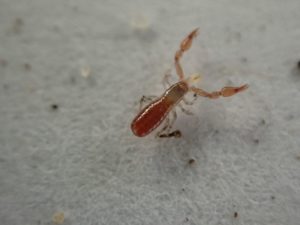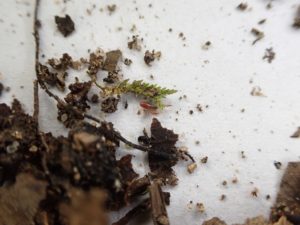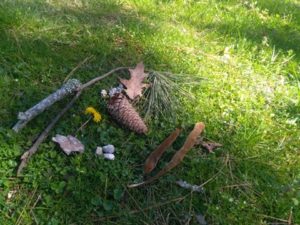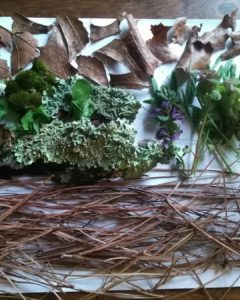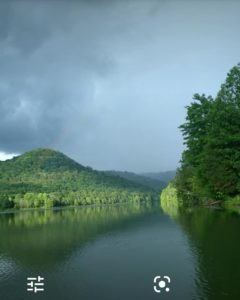Facebook: Berea College Forestry Outreach Center
Instagram: @bereacollegefoc
Click below for all of each theme’s posts!
May 4th
This week is Air Quality Awareness Week so for this Mushroom Monday, we are talking about Smooth Rock Tripe.
Smooth Rock Tripe is a type of lichen that you will find growing on rocks all over the mountain, however, its most prevalent at Eagles Nest and along Kelley’s Trail. Since they don’t grow in the soil these lichens get their nutrients by absorbing them straight from the air. Air pollution changes the chemistry of the atmosphere around these lichens. Small changes in the amount of nitrogen or the acidity of rainfall can kill these normally long-lived organisms. It is because of this that they serve as an indicator species of clean air.
#airqualityweek

Mushroom Monday
April 27th
How many of you have noticed these strange orange growths on cedar trees? The fungus responsible is Gymnosporangium juniperi-virginianae or more commonly known as Cedar-apple Rust.
The round galls found on cedar trees are producing spores right now which will be carried by the wind to apple trees up to a mile away. The spores land on the leaves of apple trees and the leaves develop yellow spots which will mature and release spores this fall that will infect more cedar trees.
Apple orchards battle this fungus each spring with strategic fungicide use and by planting more resistant apple strains.
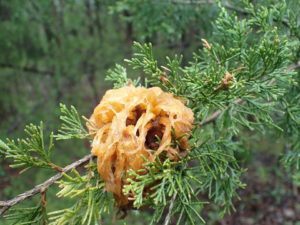
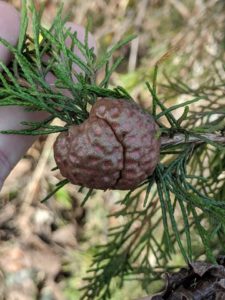
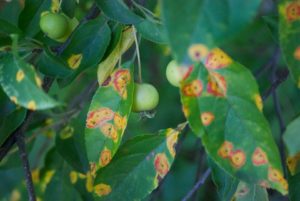
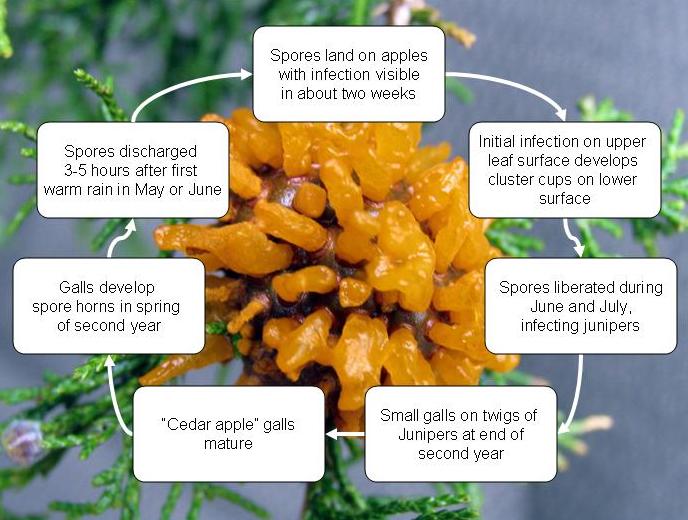
Stellar Saturday
April 25th
Brought to you by Jeff Hutton:
Look carefully at the moon. My mom used to call this a “fingernail Moon” because it looks like the thin edge of one of your fingernails. Here’s a picture I took of the Moon in 2017 that looks like it does this Sunday, April 26th, 2020.
I snapped this picture just before it was covered up by a dark cloud.
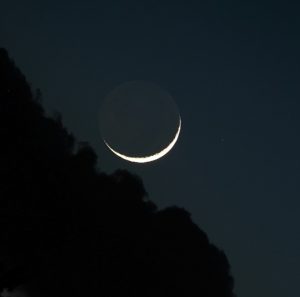
Can you see any part of the Moon that isn’t shining so bright? If it’s very clear I bet you can! The darker part of the moon, away from the sun, is the part of the moon where it’s nighttime. But if you can see the night side of the moon it must be lit a little. It is! You’re seeing part of the Moon being lit up by sunlight that was reflected off the Earth.
If we’re lucky, you’ll be able to see the moon for most of the next two weeks. In two weeks, May 7, the moon will be full.
Check out Jeff’s full activity to track the phases of the moon HERE.
Access a PDF version of the Lunar Record Observation Chart for the activity HERE.
Share what you learn with us on Facebook!
Fern Friday
April 24th
Scott’s spleenwort (Asplenium × ebenoides) is a fern that is the hybrid of the walking fern (A. rhizophyllum) and the ebony spleenwort (A. platyneuron). They are generally sterile, meaning they cannot reproduce, but some specimen have been found that have double the number of chromosomes and can reproduce. They have been classified as their own species, (A. tutwilerae). They can be found growing on limestone with a scattered distribution along the Appalachian Mountains and eastern U.S. They are evergreens that grow from dark, shiny stems and have irregular patterns. With a unique life history and story of discovery, spotting one of these would be a treat! If you’re interested, read more here: https://www.inaturalist.org/taxa/170512-Asplenium—ebenoides.
Illustrations by Elijah Hicks.

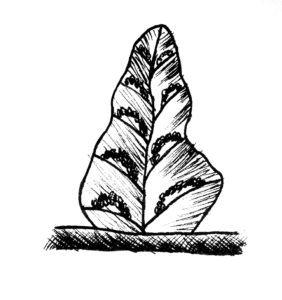
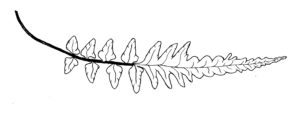
Thinking Thursday: Earth Day Edition
April 23rd
#ThinkingThursday: Earth Day Edition
Finding your own special place
Ever since I was a kid, no matter where I live, I have found my own special places outdoors where I can go when I feel like I need some time to myself. We all sometimes feel that we just need time to ourselves to think, to feel, and to reconnect with the earth that keeps us alive. I visit these places several times a week, visiting for at least 15 minutes, and sometimes much longer. I stay until my breath comes in long, slow pulls, and I feel myself start to relax. Only then, do I begin to notice the sounds of birds and insects, and feel the warmth of the sun and the gentle breeze on my skin.
My eyes begin to see things differently, too. From where I sit, I notice that there are many plants besides grass growing from the soil. I notice that in some places, the soil looks dark and in others it is light and sandy. If I sit still, I begin to see insects moving through the soil. This might be my favorite time, because when I notice the bugs, I know I am really beginning to pay attention.
Because I visit often, I see that things change from one visit to another. Sometimes I want to try to find the names for things I see and hear; other times I want to observe in a different way. I may bring a pad and pencil, to draw what I see. Sometimes I want to write the thoughts that run through my mind, because I think differently here.
As I come to know the place well, I fall in love with it. Once that happens, I become its keeper. If I see trash, I pick it up. If I pick something up for a closer look, I put it back right where I found it. I don’t want to leave any sign that I was there, because this place belongs to all the plants and animals that live here, not just to me.
Yesterday was Earth Day, a day to remember that our lives depend on the earth. This week, I hope you will find your own special place outdoors. Maybe, like me, it will help you think with both your head and your heart.
Caregivers and educators, by following this link, you can read more about the value of Earth Day, every day. https://forestryoutreach.berea.edu/…/23/earth-day-every-day/

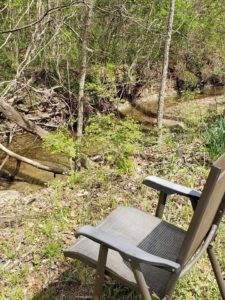
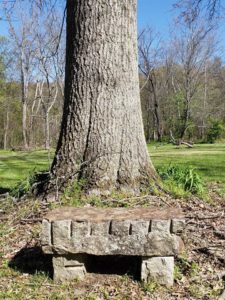
Wildlife Wednesday--Earth Day!
April 22nd
Happy Earth Day from the Berea College Forestry Outreach Center. Sadly the trails are still closed but in the spirit of Earth Day and #wildlifewednesday share your favorite wildlife photo or story with us on Facebook!
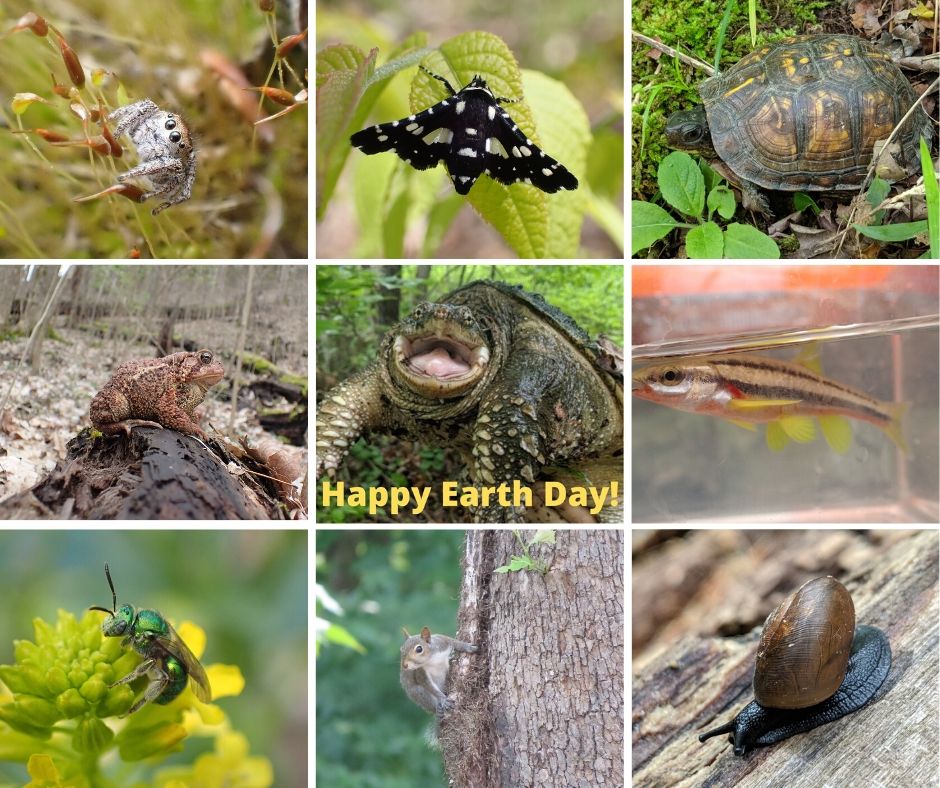
Try This! Tuesday--Seed to Sprout: Grow Your Own Plant
April 21st
With spring in full bloom, you or your little one might be wondering, “Where do all of these flowers, trees, grasses, and bushes come from?” Well, they all start out as a seed! Plants are the base for our ecosystem. They provide habitat, food, and oxygen for us and all of our animal friends. Do you know what plants need to do all of those things?
This week’s learning experience is learning about how plants grow by planting and caring for your own seed! Only a few common household items are needed.
Get hands-on in this activity by clicking the link here: https://app.peardeck.com/student/teatyytdv
(Creator’s Note: This lesson will be available for anyone to use at any time, not just today April 21st, 2020, however, the link might become unavailable after some time. Please reach out to us if the link isn’t working. THANK YOU!)
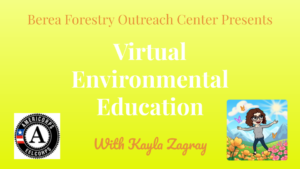
Mushroom Monday
April 20th
#mushroommonday
Did you know that some trees can grow ears?
The ear-like organism growing from this tree is actually a mushroom. Wood Ear Fungi are a type of Jelly Fungus in the family Auriculariacea. There are several species and most of them have this ear-like shape. They can be found year-round growing from dead trees.

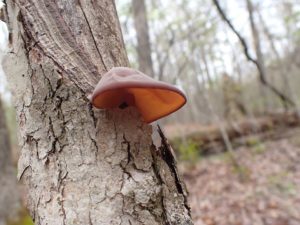
Sky Watch Sunday
April 19th
#SkyWatchSunday
On the 23rd, we will have a New Moon! While you aren't able to see the moon, the sky will be the darkest it will be all month. A perfect time for stargazing and looking out for the Lyrid Meteor Shower! More info on our website and look forward to next month's "Skies Above the Pinnacles" astronomy "forecast" by Jeff Hutton! https://forestryoutreach.berea.edu/skies-above-the-pinnacl…/
Image by NASA Goddard Space Flight Center. https://www.flickr.com/photos/24662369@N07/5837033098
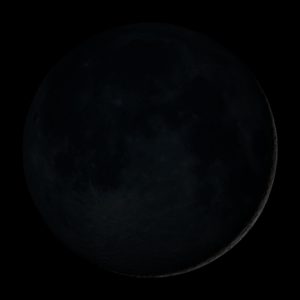
Stellar Saturday
April 18th
Did you know the Lyrid Meteor shower is coming up? What is a meteor shower? Falling stars? Aliens?
They are the debris left behind by a comet whizzing by!
How do we know a meteor shower is going to happen so we can view this awesome sight?
Read more about comets, meteors, and how to view this upcoming shower here (scroll down, the full PDF is available when you click "April Showers" above the image): https://forestryoutreach.berea.edu/virtual-lessons/


Fern Friday
April 17th
This interestingly shaped fern is wall-rue (Asplenium ruta-muraria). They are epipetric, meaning they grow on rocks, and they provide great cover for insects. You can find them in crevasses of dry, well-eroded limestone.
Illustrations by Elijah Hicks, image by John Abrams.
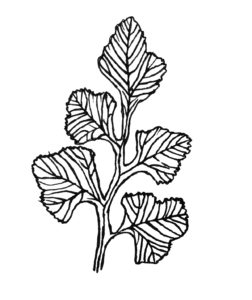
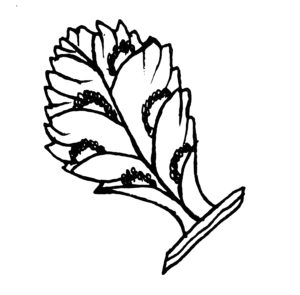
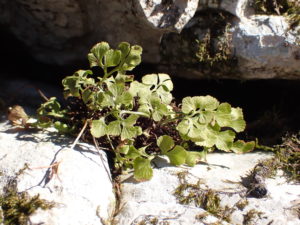
Thinking Thursday
April 16th
Happy Thinking Thursday! Each of us at the Forestry Outreach Center is making a point to get outside every single day to see what we can learn from and about the world around us. We hope you are doing the same. Remember that learning doesn’t only happen in school…it can happen everywhere, all the time. All you need to do is ask questions and then learn different ways to try to find answers.
Every time I go out, I come up with new questions, new things that I wonder about. I’ve attached a few photos of things that raised questions for me. In fact, I can think of lots of questions about each photo. Perhaps questions will for you, too. I sometimes use them to play a game of “What happened here?
Sometimes my questions are about plants or animals I want to try to identify, like a bird or a tree. I also often wonder about how a plant or animal got its name, and who decided how to name it.
Sometimes my questions will be more complicated, as I wonder how one thing affects another. I wonder, for example, how long it might take for the earth to break down pavement once people aren’t using it anymore. I wonder, too, about how ants work together as I watch one carry something back to its anthill. Or I’ll find a fossil in rock and wonder what it is, how old it is, and when it got there.
And sometimes when I’m outdoors, I’ll wonder about a problem I’ve heard about on the news, like climate change or polluted air or water, and I’ll want to learn more about that. I often wonder why some people say something is a problem when others say its not. Knowing that people think about problems in different ways gives me plenty to explore and think about.
Or I ask: I wonder what would happen if…and then I fill in the blank. What would happen if all the earth’s rich topsoil erodes into the rivers and oceans? What would happen if we cut down so many trees that it made oxygen levels drop? These questions can guide my learning to help me think about ways I can help solve or prevent a problem.
It feels good to be learning toward a solution. In fact, this is the only way people have ever imaged solutions. If they can do it, why not you or me? I learned from an author named Zoe Weil that one way to find problems to solve is to ask 4 questions: What challenges in the world most concern me? What do I love to do? What am I good at? What do I need to learn?
Then she suggests finding solutions that do the most good and the least harm to the earth and all its beings.
I also wonder about things that are happening right now. Right now, I’m interested in learning about viruses like Covid 19, for example, what they are, how they spread, and why some viruses are more contagious than others.
Thinking Thursday might be a day for you to explore some questions you have. Once you catch on to guiding your own learning this way, you can never be bored again!
Caregivers and Educators, you can learn more about the source of some of these ideas on the accompanying blog. Just click here: https://forestryoutreach.berea.edu/2020/04/15/3558/
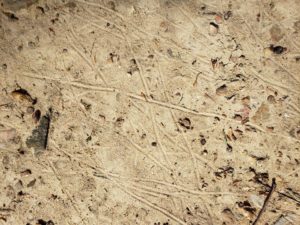

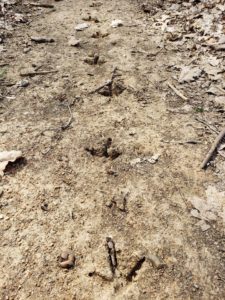
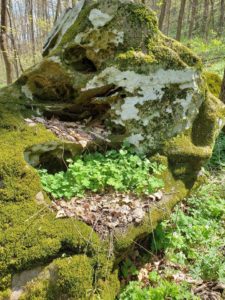
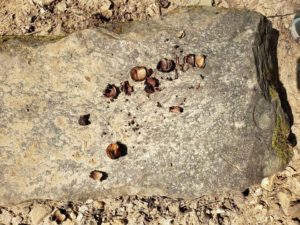
Wildlife Wednesday
April 15th
It's mid-April and that means Orioles are returning and seeking out territories. Putting out feeders right now will give you a good chance at attracting a pair to your yard. You can purchase feeders made specifically for orioles that are similar to hummingbird feeders, or you can simply place orange halves on tree branches or fence posts in your yard.
How to make an Orange Feeder for Orioles
https://www.audubon.org/news/make-orange-feeder-orioles
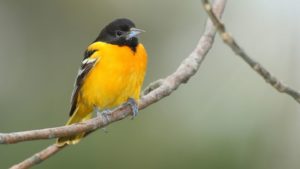
Try This! Tuesday
April 14th
Have a few pieces of paper, crayons, a blanket, and a paper bag? Then you can have yourself a puppet show! Find inspiration to make your own native wildlife puppet show here! If you make any puppets and/or a show, please share with us on Facebook or Instagram (@bereacollegefoc)!
Mushroom Monday
April 13th
The Dryad's Saddle mushroom is a common find on hardwood logs and snags throughout the Eastern US. They can grow to be over a foot across so they are hard to miss. Young mushrooms are edible but as they get larger they get leathery and unappetizing. The dark scaley pattern on the top of the mushroom is where it gets another common name of Pheasant's Back.
What mushrooms are you finding while you are out and about?
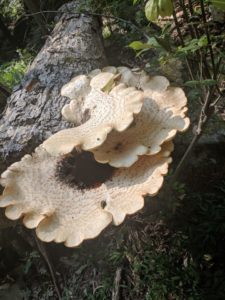
Sky Watch Sunday
April 12th
We often forget to look up at the night sky, but it is an important part of life on Earth! Try taking a look and use this guide to April's astronomical events by Jeff Hutton to help decipher what you're seeing... And there's a meteor shower coming up! Get more info here!
https://forestryoutreach.berea.edu/skies-above-the-pinnacles/
Stellar Saturday
April 11th
Hey, check out the moon! Did you notice how big the full moon was before clouds closed in on April 8? Maybe you heard someone call it the “Super Moon”. If you’d like to learn more about that, read this month’s “The Skies over the Pinnacles” or go to NASA’s website at www.NASA.gov and type in “Super Moon” in the Search Box. The moon always seems to be changing its shape doesn’t it? You might have also heard terms like “New Moon” or “First Quarter Moon”. Curious? Read on and find a fun activity here: April 11 Check out the Moon! PDF

Thinking Thursday
April 9th
Thinking Thursday: More Divergent Thinking
While you are staying “Healthy at Home,” you may notice your family is shopping less and being more careful not to waste food. I hope last week’s Thinking Thursday is helping you find interesting ways to REUSE materials you might have thrown away. The earth would be grateful if our REDUCE and REUSE habits would continue even after we can go to stores again!
This week let’s practice divergent thinking in a different way. Try this: Look out a window or step outside. Imagine away all the houses, all the stores and any other building you can see. Now, imagine away the roads, the telephone poles, the electric lines…and everything else that is made by humans.
Now, let’s say you wanted to meet a friend. How would you tell them where to find you? How might you describe or map your meeting place?
How would you meet your basic needs of food, water, and shelter? Where could you find water and food, and how might you create shelter? What other tools might you need to make your life easier and more comfortable?
Did you know buffalo used to roam Kentucky? I’ve posted some photos of useful items people have made from different parts of a buffalo. See if you can figure out what part of the animal it is, and what it was used for. If you click on each photo, there will be a place you can share your thinking.
This is the kind of divergent thinking people have used, and some still use, in order to survive. People learn how to live on the earth by carefully watching everything that happens. Observing the earth was a very important way to learn. Many generations of people learned and lived this way right here in Kentucky. When people live this close to the earth, they know how important it is to also care for it—to keep it clean and healthy---because our lives depend on it. Do some research to find people who continue to live this closely to the earth. You can post what you learn in the comment section below.
(Note: photos were taken at Chief Dull Knife College in Lame Deer, Montana, and published on a calendar produced by Full Circle Curriculum and Materials)
Blog post here: https://forestryoutreach.berea.edu/2020/04/09/thinking-thursday-april-9/

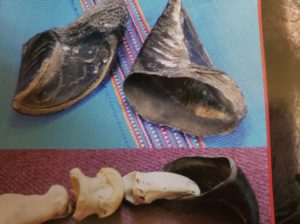
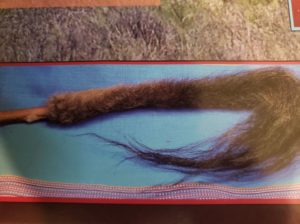
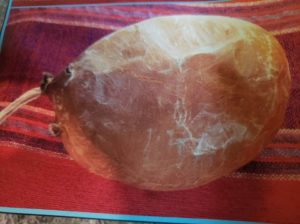
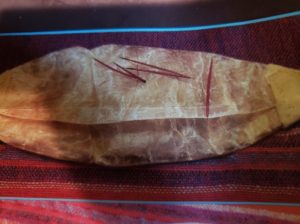


Wildlife Wednesday
April 8th
For this #wildlifewednesday, meet the Eastern cottontail!
While many people might just think of rabbits as cute, they are also an important part in our ecosystem. They are an important food source for a wide range of animals like foxes, bobcats, and even owls. They have many interesting adaptations that make them a formidable prey animal.
(Watch for a video coming soon about these traits...)
This time in the spring is when these rabbits tend to start having litters of 3-8 kits. If you see a rabbit nest and the mother is not present, it does not mean she has abandoned them. Unless they are physically injured, just leave them be and the mother will likely return. Check your lawns before mowing in case you might be lucky enough to have baby bunnies growing up in your yard! The babies will be old enough to leave the nest in only 3-4 weeks.
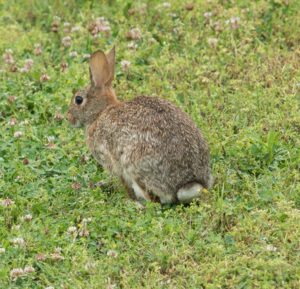
Try This! Tuesday
April 7th
Warm weather is finally here, and you know what that means? Bugs, insects, and all the critters! We're sad that our usual springtime activities won't be happening, but we don't want anyone to miss out on what's occurring in the ecosystems all around us! For this week's Try This! Tuesday, join a step by step virtual environmental learning experience put together by our Certified Environmental Educator, Michelle. Using this link (https://app.peardeck.com/student/tvzosfgur), you can join an interactive lesson showing you how to do an environmental experience in your own yard at your own pace.
This week's learning experience is about ants and how they work!
(Creator's Note: This lesson will be available for anyone to use at any time, not just today April 7th, 2020, however, the link might become unavailable after some time. Please reach out to us if the link isn't working. THANK YOU!)
Mushroom Monday
April 6th
#mushroommonday
Today's mushroom is the Black Sooty Mold Fungus. This dark black fungus is found exclusively on American Beech trees, but it doesn't feed on the tree, at least not directly. The Black Sooty Mold Fungus is actually feeding on the waste of the Beech Blight Aphid. The aphids drink sap from the trees and excrete a sugar rich liquid known as honeydew, and that sugary liquid is what the the fungus is feeding upon.
Beech Blight Aphids have a defensive behavior where they will wave their bodies around when they feel threatened...this behavior has led to some people calling them "boogie woogie aphids"
https://youtu.be/gdIqdepyynw

Sky Watch Sunday
April 5th
Check out this awesome #skywatchsunday image taken of the Venus/Pleiades star cluster conjunction the past few nights! You can see Venus without a telescope or binoculars because it is so bright. It passed right by the star cluster, but only from our point of view! They are still far, far away from each other in space.
Share with us what you see in the night sky where you are!

Stellar Saturday
April 4th
Telling Time with the Stars
by Jeff Hutton
Did you know that hundreds of years ago there were no clocks? Just like now, there were people who were clever and they realized that the sun, moon and stars always rose in the east, traveled across the sky and set in the west. They also knew that certain stars were up at night only at certain times of the year and that the stars that were close to the sky’s north pole, near the star called Polaris, never set. These stars just went round and round Polaris like a big wheel
Just like now, it was important to know what time of the year it was so they knew when to celebrate religious holidays and for farmers to know when to plant their crops.
Would you like to be able to tell time without a clock, your watch or a smart phone?
Do the activity here: Telling Time with Stars PDF
Thanks to Jeff Hutton. Diagrams from Astronomical Society of thePacific's "UAYF 2.0" https://astrosociety.org/

Fern Friday
April 3rd
Happy #fernfriday !
This is an American Royal Fern (Osmunda regalis var. spectabilis). There are multiple royal fern species spread around the globe. They grow in wet, sandy, limestone-based soils in the shade. When they produce spores, the structures that do so can look flower-like, which is why another common name for this species is Flowering fern!
Have you seen any ferns lately? Post your pictures below, and, if you haven't tried out iNaturalist to track species you find and contribute to our citizen science project "Biodiversity of the Berea College Forest," try it out!
Drawings by Elijah Hicks.
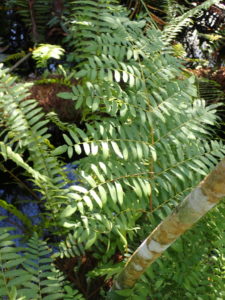

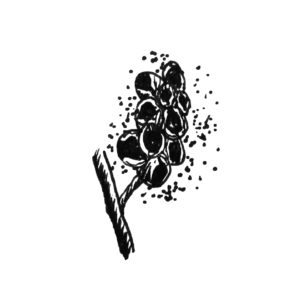
Thinking Thursday
April 2nd
Thinking Thursday: REDUCE, REUSE, recycle: divergent thinking part 1
Right now, with most of your family at home, you’re probably producing a lot of trash. Trash companies are having a hard time keeping up, and recycling has slowed ever further. You’ve probably heard the phrase “REDUCE, REUSE, recycle.” But has anyone ever told you that to treat the earth well and help it recover from damage, we should think about it in that order? In fact, recent reports have shared that the plastic industry has pushed recycling so that we would feel better about our continued use of plastics.
One way to REDUCE what you need to buy is to REUSE the things you would otherwise throw away. This takes some creative thinking, and it’s the kind of thinking we’ll invite you to do this week. This is also stretch your brain to do an important kind of thinking called divergent thinking. To diverge means to go in a different direction. Divergent thinking, then is allowing your brain to go a different direction so it can come up with a new idea. People who come up with inventions and new ways of doing things use divergent thinking.
In the photo below, I used divergent thinking—and some trash—to try to solve a problem. Can you figure out what problem I was trying to solve? It didn’t work right at first. I put on one layer of plastic at a time. The first two layers didn’t solve the problem. I kept watching, trying to figure out why it wasn’t working. Finally, I added the top layer and cut the plastic on the top tow layers so it would flap around. Since then….problem, solved. So sometimes you can REUSE things, like trash, in ways that solve a problem.
In the photos below, I have taken photos of some of the things that I might throw away, unless I find ways to REUSE them. You might think of some ways they might solve problems around your house, especially as we’re not able to go shopping as much. Think of this as a game. You’re allowed to change the things any way you want to, like I did by cutting the plastic above the bird feeder. In the comment section below, name one of the objects—and share an idea for ways you might REUSE it. Let your imagination go wild! Maybe you’ll come up with a whole new invention!
We also invite you to post photos of ways you might have found to REUSE some of the trash around your house. If you get good at this, you can buy and throw things away much less than I used to!
Parents and educators can follow this link to read our blog post about the importance of practicing divergent thinking https://forestryoutreach.berea.edu/…/fostering-divergent-t…/
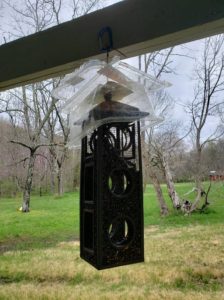
Wildlife Wednesday
April 1st
Today is April 1st and that means its time for the Ruby-throated Hummingbirds to return.
Every Spring the Hummingbirds that you see at your feeders migrate here from southern Mexico and Central America. Many of the birds will make a non stop 900 mile trip flying over the Gulf of Mexico, and thats only about half of the distance they need to migrate before they make it to KY. When they get here they will need fresh nectar sources, so now is a great time to put out a feeder.
Hummingbird nectar is easy to make its 1 part sugar to 4 parts water, thats 1/4 cup of sugar for every cup of water in your feeder. Don't use any red dyes in the nectar but red colored feeders are a good idea. Be sure to take your feeders down and wash them thoroughly about once a week.
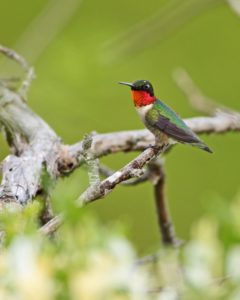
Try This! Tuesday
March 31st
For today's Try This! Tuesday, we made interpretive art using natural materials. The inspiration picture is of Owsley Fork Reservoir. Try it for yourself and share your art with us!
Mushroom Monday
March 30th
This week's mushroom is probably well known to some of you. Every spring around this time you can find morel mushrooms in forests across Kentucky. They are the inspiration for numerous festivals and are many people's first experience with wild mushroom hunting.
We have six species of Morels but most folks just lump them into two categories.
Yellow Morels that typically are the first to show up in the spring will usually be found near some type of dead or dying hardwood tree, Elm, Ash, and Poplar are common hosts.
Black Morels will start fruiting in the coming weeks they are a bit less picky about habitat. They can be found in deciduous and coniferous forests across the state.
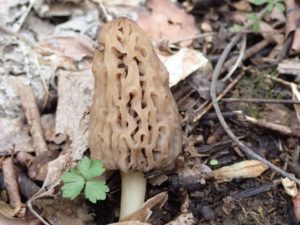
Stellar Saturday
March 28th
Take a look at this article about stargazing from home. Whether it be virtual or if you can get a good view from your home, space is an amazing thing to learn about. It affects our daily lives in ways we don't even know! Take a look at the night sky tonight and tell us what you see!
https://www.cnn.com/…/stargazing-quarantine-sess…/index.html
And from NASA: www.nasa.gov/nasaathome
Fern Friday
March 27th
Check out this awesome fern, Kentucky spleenwort (Asplenum x kentuckiense)! This is actually a hybrid species between a lobed spleenwort and an ebony spleenwort. They grow on sandstone cliffs and are quite rare and can easily be mistaken for other hybrid fern species.
Illustrations by Elijah Hicks, photo from wildflower.org.
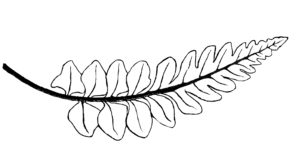
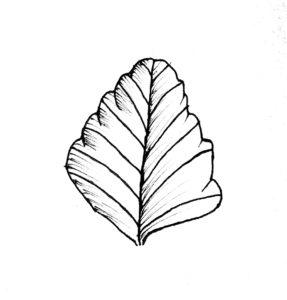
Thinking Thursday
March 26th
For this week’s Thinking Thursday, become a nature detective!
When you go out into the natural world and begin to really look, as last week’s Thinking Thursday suggested, all kinds of questions probably come to your mind. This week, we invite you to become a Nature Detective.
Last week, I went for a long walk in the woods. I took a number of photos, which I’ve posted here. I’ve asked some questions about each, which I’ll post in the comment section beneath each photo. To find the questions, click on the photo. Once someone has posted an answer….see if you can dig even deeper. If, for example, someone’s answer was “an insect,” ask another question. It might be, “what kind of insect?” “What does it eat?” Let’s keep the questions and answers going as long as we can for each photo and see how much we can learn.
We also invite you to also post your own photos in the comment space below this post and share your questions about them. Let’s see if, together, our learning community can come up with answers.
If you can’t get outside, you can also try this: Look at the photos posted lately on the Forestry Outreach Center’s FB page. Some provide information for you, but I’ll bet you can still come up with plenty of questions about them. See if you can find answers—by observing outdoors or researching online or talking with people—and post your question and answers below any photo. This is a great way for us to form a community where we can all learn together.
PARENTS, learn more about inquiry-based learning and learning communities by reading the newest blog post on the Forestry Outreach Center website by clicking this link: https://forestryoutreach.berea.edu/…/why-inquiry-based-lea…/
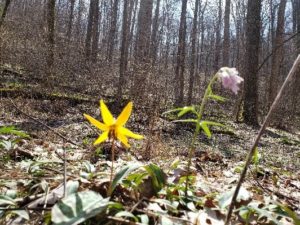
Wildlife Wednesday
March 25th
Our Naturalist, John Abrams, made a short video about a garter snake he found! Check it out here!
#wildlifewednesdaySigns of spring are all around, for those of us who like snakes, an Eastern Garter Snake is a welcomed sight. For those of you who may not big fans of snakes, you may be comforted to know that this particular snake wasn't found at the Pinnacles.
Posted by Berea College Forestry Outreach Center on Wednesday, March 25, 2020
Try This! Tuesday
March 24th
Try making this beautiful origami flower! All you need is a square sheet of paper. Here is a video with instructions!
Mushroom Monday
March 23rd
All of this rain is sure to bring out some interesting fungi in our forest. The Gray Urn and the Scarlet Elf Cup can both be found growing from the ground near fallen hardwood trees and branches.
The Gray Urn (Urnula craterium) is darkly colored and hard to spot. It prefers to grow on fallen oaks but it can be parasitic to live oak trees as well. This mushroom produces a bioactive compound that inhibits the growth of other fungi.
The Scarlet Cup (Sarcoscypha species) are a common find along the trails due to their bright red coloration. Scarlet Cups grow in the same habitats as the Gray Urn except it prefers to grow from willow and maple. Native Americans would dry and grind the mushrooms into a styptic powder that would commonly be used to treat the navels of newborns.
What mushrooms have you found lately?


Fern Friday
March 20th
This is a walking fern (Asplenum rhizophyllum), illustrated by our labor student, Elijah Hicks! These ferns are found growing on boulders, stumps, and rarely, on the ground. They grow in areas with limestone and other basic rocks and dislike acidic rocks like sandstone. Its distribution varies from the central U.S. to the east coast--in some places it is very abundant while in others it is endangered. Image by John Abrams, info from iNaturalist.
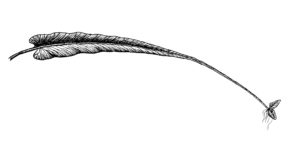

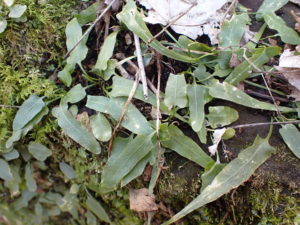
Thinking Thursday
March 19th
Welcome to Thinking Thursday with the Berea College Forestry Outreach Center! Every Thursday, we’ll share a post designed to spark your curiosity and invite you to post what you notice, questions that it brings up for you, and what you learn as you research or experiment.
This week, we invite you to explore the wonders of your own backyard or a nearby park. If that doesn’t seem so wonderful, maybe it’s time to look again with new eyes. Here’s this week’s challenge:
Spend 10-15 minutes or so watching what happens in your yard. Try this for a whole week. If it’s raining, you can just look out the window. Observe what’s moving—and what’s not. Do you see any animals? Insects? Keep watching. Allow questions to arise. I wonder what kind of tree that is? How can I tell if there are no leaves on it yet? What’s that squirrel eating? How many birds can I count in 10 minutes? What kinds of flowers are blooming in the lawn? What’s the green stuff on the trees? Why do some of the trees still have dead leaves on them? Which direction is the wind blowing? How can I tell? How can I tell how much rain has fallen?
Choose a question you’re really curious about and think of some ways you might find an answer. But don’t stop with one answer. Try another source of information and see if that answer is the same. Then let that answer lead you to more questions….and keep going. It might be a good idea to start a notebook to keep track of what you learn on Thinking Thursdays!
We invite you post a photo of something you noticed or a drawing or a piece of artwork you created that let’s us “see” it, too. Then write or post a short video to share what you learned about it. Let’s see if we can keep this thread going all week. We can’t wait to see what we can learn from all of you!
Parents: For more information about Inquiry-based learning, follow this link to a blog post on the Forestry Outreach Center website for more information. https://forestryoutreach.berea.edu/…/…/18/lets-get-curious/…

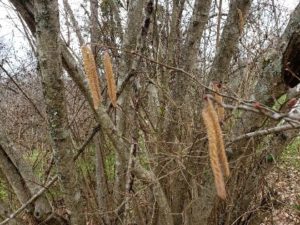
Wildlife Wednesday
March 18th
This strange-looking arachnid is a Pseudoscorpion or false scorpion. They are common in the forest but they are incredibly small, typically less than 5mm. Unlike real scorpions they do not possess a tail with a stinger, instead, they have glands in their claws that inject venom into prey.
Pseudoscorpions are found in the leaf litter, under bark, and some species even live in old books where they feed on even smaller insects like dust mites and booklice. If you look closely in the photo you can see a tiny ant larva in the pseudoscorpions mouth.
